|
Painting
and Finishing "D-32"
Getting
excited to move into the finishing stages, I
totally neglected to take any photos of the
priming process. No new information here, I
always prime in acrylic Flat Black, and did
so this time around too. I just didn't think
anyone would be interested in looking at and
all-black model miniature. Before applying
the paint, I dabbed a very light and
selective coat of acrylic gel medium to
areas of the lower hull to give relief and
the impression of accumulated mud/dirt.
My
base color coat is acrylic Polly Scale USAAF
Olive Drab, with a camouflage coat made by
mixing acrylic Tamiya Flat Black and NATO
Black. Airbrushed freehand, I tried to make
the edges as sharp as possible. In scale,
from a casual viewing distance, the
feathering should appear sharp - almost like
hard-edged camouflage.
For
the first time, I painted the Pioneer Tools
in place on the miniature, with the
camouflage coat crossing over them. I used
Lion Roar Stencils to airbrush the US
National Symbols on the engine deck and
turret roof.
I
worked the same colors on the lower hull as
I used in creating a display base, which I
ultimately decided not to use. I used
acrylic Polly Scale Dirt, along with VLS
Figments and MiG's Europe Dust - all three
colors complimentary and showing accumulated
mud/dirt in slightly different shades. I
painted the track runs and Road Wheels
separately, before bringing them all
together for the weathering steps.

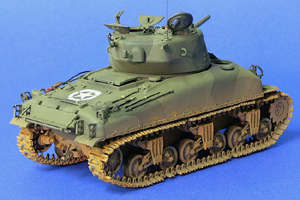
To add
some depth to the lower hull dirtying
process, I applied a localized wash of Raw
Umber oils. I thinned my Dirt airbrush
mixture and reduced the air pressure in the
airbrush as I proceeded to blend in
subassemblies as I added them to the
miniature in phases.
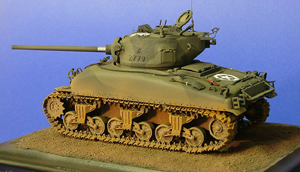
Modeling
a Panther Killer
Though
Dragon's decal sheet is really attractive, I
decided that I wanted to model a different
M4A1(76)W for my collection. I chose to
render one of a force of Shermans assigned
to Task Force Kane - one that destroyed two
German Panzer V Panther Medium Tanks on
Christmas Eve, 1944. The description of the
battle influenced how I went about
weathering and finishing the miniature.
Task
Force Kane and other elements of the US 3rd
Armored Division engaged the German 2nd SS
Panzer Division "Das Reich" on 12/24/44
during what would later be called the Battle
of the Bulge. I referenced the engagement as
described by George Winter in the book
"Frieneux and La Mormenil - The Ardennes",
JJ Fedorowicz Publishing, for building my
miniature. Further description of the battle
comes from an interview with Reece Graham on
the 3rd Armored Division Association
Website. What I relate about the action
below is pulled together from both sources.
Task
Force MacDonald was a small sub-force of ten
Sherman Combat Tanks and two Assault Tanks
dispatched from Task Force Kane down from
HWY 15 to help protect the Crossroads
(Objective 576853). Colonel Kane split his
Task Force into three teams to reconnoiter
the German positions and to ascertain their
objectives in the vicinity of Stolberg,
sending TF MacDonald on their mission 21
December 1944. The two Assault Tanks of TF
MacDonald would be left behind at the
Crossroads in the aftermath of repulsing a
German attack, and the ten Sherman Combat
Tanks remaining were ordered to head
westerly to aid Task Force Orr, in the
vicinity of Odeigne, La Mormenil (Objective
503861) and Frieneux (Objective 513862) on
22 December. TF MacDonald remained in
Odeigne overnight and moved into Frieneux on
the morning of 23 December to clean out
German resistance. They encountered a large
pocket of German troops outside the village,
but were unable to capture or breakup this
force.
One
M4A1(76)W Sherman Tank of "D" Company, 32nd
Armored Regiment, a part of Task Force
MacDonald, was positioned next to a small
house in the village of Frieneux. This tank
was under control of Tank Commander Sergeant
Reese Graham at daybreak on 24 December.
Graham recalls an infantryman running up to
his tank, mounting it and informing him that
four German tanks were approaching from
across the valley in the general direction
of village of La Mormenil. Across the road
from their position was a small stone fence,
beyond that an open field across the valley
towards the village of La Mormenil.
Another runner came up to Sergeant Graham's
tank, telling him that their Sherman
couldn't move - it had gotten frozen into
the soft ground overnight. This tank had
pulled up behind a woodpile near a barn the
previous afternoon. Sergeant Graham and his
crew moved their Sherman over to hitch it to
the stuck tank and attempted to free it.
While hooked up to the stuck Sherman, a
Panther got off a shot that penetrated it -
disabling it. Sergeant Graham's crew had a
difficult time unhooking from the disabled
Sherman, but did so and returned to their
previous position next to the small house.
Sergeant
Graham spotted and fired upon the Panther
that knocked out the stuck tank. The Panther
returned fire. Two rounds missed Graham's
Sherman, but hit the house behind his tank,
showering it with debris. His Sherman tank
fired two more rounds at the Panther, both
missing high because the Panther sat in a
shallow depression out in the dale and
Graham's tank could not depress the 76mm
cannon deep enough to hit it. Sergeant
Graham relates that he could see the
Panther's gun barrel sticking up, and
backing down out of sight, as the German
crew jockeyed for position to fire upon him
again.
Sergeant
Graham spotted another Panther opening fire.
He estimated the range at 2000 yards, and
gave the order to his Gunner. Firing a
tracer round, he saw that the shell struck
in direct line to target, but fell short.
Sergeant Graham gave adjusting fire orders
and his Gunner fired again. This shot
penetrated the rear quadrant of the Panther,
setting it on fire.
Sergeant
Graham then spotted another Panther moving
from right to left behind the one he just
knocked out, heading up the road towards
Odegin. He called out fire orders, and his
Gunner scored another kill - the shot also
striking the rear quadrant of the second
Panther, setting it ablaze.
"D-31",
another M4A1(76)W Sherman commanded by
Lieutenant Meyers, was positioned near
Sergeant Graham's tank "D-32". Lieutenant
Meyers was attending the morning briefing
with the other officers when the action
began, with Gunner Corporal James Vance in
charge of "D-31". Vance was alerted to the
approaching German Force in the same manner
that Sergeant Graham was over in his tank.
With his Sherman positioned alongside a
stone wall next to a Church, Vance ordered
his Driver to start the tank and traversed
his Turret towards the open field in effort
to get a good shot off as soon as the
Germans came into view.
Corporal Vance opened fire upon the
advancing German Panthers at the moment the
two lead tanks crested a small hill out in
the field beyond his position. Erich
Heller's Panzergrenadiers jumped off the
Panther they had been riding, to seek cover
nearby when the round came in. Heller
relates he spotted the fire coming from
Vance's Sherman, partially hidden behind a
Church wall ahead of them. Corporal Vance
states he watched the four Panzers coming
across the hill with their flanks to his
position. Vance ordered his Gunner to fire,
striking Obersturmfuhrer (1st Lieutenant)
Pippert's Panther. On fire, Pippert's crew
bailed out of their tank.
When
Vance saw that he had hit one of the
Panthers, he came up from his sights to
locate another tank. Picking up a new
target, Corporal Vance ducked back down into
the Turret, sighted, and fired another
round. This round hit the second Panther.
Then
Untersturmfuhrer (2nd Lieutenant) Fritz
Langanke relates in the narrative that the
second tank Vance hit was Untersturmfuhrer
(2nd Lieutenant) Kurt Seeger's Panther. The
Panther had suffered a frontal hit - but low
on the underside where the armor was
thinnest - as the Panther crested the hill.
Corporal
Vance quickly located a third Panther
(Kirchner's tank), and prepared to fire upon
it. As he ducked down to his sights, and got
ready to pull the trigger, Vance saw that
Kirchner's Panther had just been hit. It's
likely that Kirchner's Panther was hit by
Sergeant Graham's Gunner. By the time
Corporal Vance reemerged from the Turret to
locate the fourth Panther, it was gone from
his field of view.
Out of
the view of Graham's and Vance's tanks, the
fourth Panther had determined the location
or vicinity from which Corporal Vance's
"D-31" lay - because it opened fire upon it.
The Panther's round hit the stone wall just
to the right front side of "D-31", but did
not damage the Sherman. Unable to locate the
Panther for counterfire, Corporal Vance
ordered his Driver to back "D-31" behind the
Church and out of the line of fire.
|
The
actions of Vance's "D-31" and Graham's
"D-32" M4A1(76)W Sherman Tanks partially
halted the advance of the German 2nd SS
Panzer Regiment into Frieneux that day. At
the end of the engagement, eight Shermans
and eight Panthers had been either
disabled or destroyed. I was not able to
gather from either German nor American
accounts of the action any nicknames or
special features (like chrome yellow
codes) on either tank American tank
participating in the action.
I
took a conservative approach in modeling
"D-32", refraining from heavy damage and
over weathering popular in AFV modeling
today because the photos of the vehicles in
the unit show well-maintained and equipped
Sherman tanks. I positioned my turret crew
midway between popping up in their hatches,
and ducking back down into them, so that I
could imagine any phase of that battle on
Christmas Eve morning.
Looking
back over the project, I don't think I could
have picked a better model kit than Dragon
Models M4A1(76)W Operation Cobra Sherman for
this project idea. I remember putting it
together fondly and I hope it does justice
to the memory of the men who fought a battle
little known to AFV modelers.
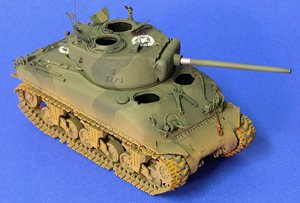
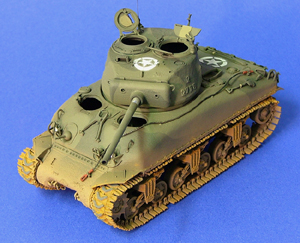
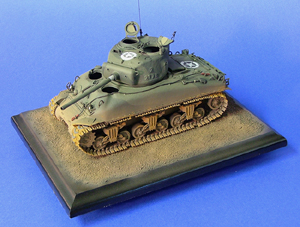

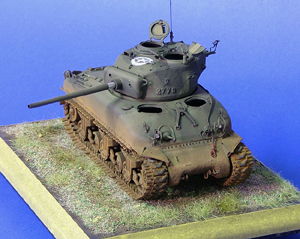

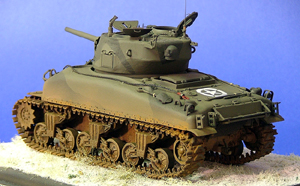
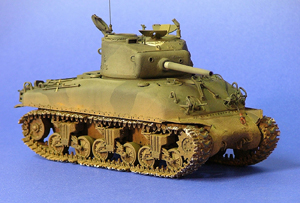

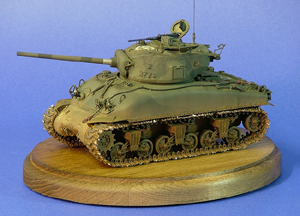
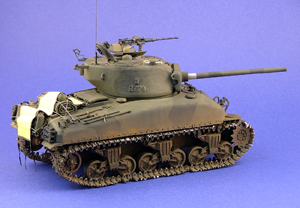
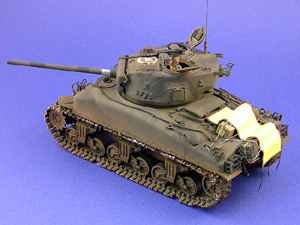

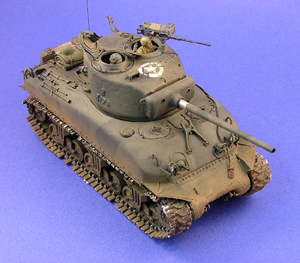
|